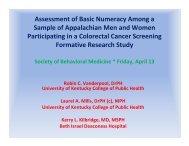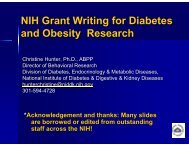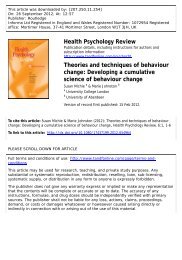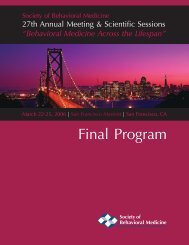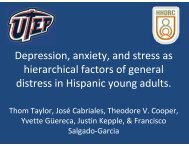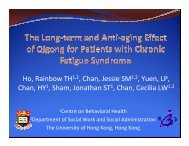2007 Final Program - Society of Behavioral Medicine
2007 Final Program - Society of Behavioral Medicine
2007 Final Program - Society of Behavioral Medicine
Create successful ePaper yourself
Turn your PDF publications into a flip-book with our unique Google optimized e-Paper software.
SOCIETY <strong>of</strong> BEHAVIORAL MEDICINE<br />
Rapid Communications Posters Friday, March 23, <strong>2007</strong> • 6:30 PM-8:00 PM • Poster Session C<br />
observe and record physical activity, including the address where the<br />
physical activity was taking place, the number <strong>of</strong> participants, and<br />
the activity in which they were engaged.<br />
Results: Agreement was calculated for the address <strong>of</strong> the physical<br />
activity, the number <strong>of</strong> participants involved and the type <strong>of</strong> activity<br />
observed - 79.1%, 87.8% and 76.9%, respectively, with a combined<br />
agreement <strong>of</strong> 81.3%. The number <strong>of</strong> participants for each activity<br />
observed also is provided.<br />
Conclusion: The levels <strong>of</strong> agreement were acceptable to conclude<br />
that the BWM is reliable in a suburban setting, but there are a<br />
number <strong>of</strong> procedural adjustments to be made to further enhance<br />
the reliability.<br />
CORRESPONDING AUTHOR: Jessica Fritzsinger, DO<br />
Candidate, Kansas City University <strong>of</strong> <strong>Medicine</strong> and Biosciences<br />
- College <strong>of</strong> Osteopathic <strong>Medicine</strong>, Kansas City, MO, 64124;<br />
jfritzsinger@kcumb.edu<br />
3428<br />
DIFFERENCE BETWEEN SELF-REPORTED ENERGY INTAKE<br />
AND ESTIMATED ENERGY REQUIREMENT IN A LATINO<br />
POPULATION AT RISK OF DEVELOPING DIABETES<br />
Barbara C. Olendzki, RD MPH, Yunsheng Ma, PhD, Sherry L.<br />
Pagoto, PhD, Jennifer A. Griffith, MS, Philip A. Merriam, MSPH,<br />
Vijayalakshmi Patil, MS and Ira S. Ockene, MD<br />
Preventive and <strong>Behavioral</strong> <strong>Medicine</strong>, University <strong>of</strong> Massachusetts<br />
Medical School, Worcester, MA.<br />
Objective: Underreporting <strong>of</strong> energy intake has been associated<br />
with higher body mass index(BMI); however studies in minority<br />
populations are limited. A cross-sectional analysis was conducted<br />
to examine the difference between self-reported energy intake and<br />
estimated energy requirement, and evaluate factors associated with<br />
this difference, in a low income, lower literacy Caribbean Latino<br />
community in Lawrence, Massachusetts.<br />
Subject: One hundred and sixty-two Latinos were assessed as part <strong>of</strong><br />
a diabetes prevention study. The eligibility included a ≥30% risk <strong>of</strong><br />
developing diabetes in 7.5 years, assessed with the Stern formula.<br />
Methods: Demographic, dietary, and psychosocial data collected at<br />
baseline was used for this investigation. Dietary self-reported energy<br />
intake was collected using three randomly selected days <strong>of</strong> 24-<br />
hour diet recalls. Total energy expenditure was estimated using the<br />
Mifflin-St Jeor equation.<br />
Statistical Analysis: The energy difference was calculated using<br />
24-hour derived energy intake minus estimated total energy<br />
expenditure. Linear regression analysis was used to identify factors<br />
associated with this difference.<br />
Results: The population was predominately female (77%), average<br />
age 51 years [standard deviation (SD)=11], BMI 35kg/m2<br />
(SD=5.8), 62% had less than high school education, 56% were<br />
unemployed, and 35% had siblings with diabetes. Reported total<br />
daily energy intake was 1552 kcal (SD=610), whereas daily total<br />
energy expenditure was estimated at 1909 kcal (SD=315), with a<br />
difference <strong>of</strong> -357 kcal (SD=591). Higher BMI, having siblings<br />
with diabetes, and being married was positively associated with<br />
underreporting <strong>of</strong> energy intake.<br />
Applications/Conclusions: This is the first study to describe dietary<br />
intake under-reporting in a low-income, lower literacy Caribbean<br />
Latino population. It has implications for future analyses and<br />
collecting <strong>of</strong> the dietary data in this population.<br />
CORRESPONDING AUTHOR: Barbara C. Olendzki, RD MPH,<br />
<strong>Medicine</strong>, UMass Medical School, Worcester, MA, 01655; barbara.<br />
olendzki@umassmed.edu<br />
3429<br />
A COMPARISON OF BODY IMAGE DISCREPANCY<br />
MEASUREMENT IN THE LABORATORY AND DAILY LIFE<br />
Kristin Heron, MS and Joshua Smyth, PhD<br />
Syracuse University, Syracuse, NY.<br />
Self-discrepancy theory is a useful framework for exploring how<br />
individuals view their bodies. Body image discrepancies [BID]<br />
result from conflicting beliefs about one’s actual body and the body<br />
one would ideally like to have (actual:ideal discrepancy [A:I]), or<br />
beliefs about the body one ought to have (actual:ought [A:O]). BID<br />
are interpreted as a measurement <strong>of</strong> body image dissatisfaction,<br />
and are associated with disordered eating behaviors, dieting, and<br />
weight control attempts. BID are generally measured using a figure<br />
rating scale in a laboratory or clinical setting, although there is<br />
little evidence that this measurement technique represents actual<br />
experiences. Laboratory-based assessments may be problematic as<br />
phenomenon measured in artificial settings may not be indicative<br />
<strong>of</strong> processes that occur in the real world. This study used Ecological<br />
Momentary Assessment [EMA] to assess BID in everyday settings.<br />
College women (n=63; mean age=19.0) completed BID measures<br />
in a laboratory and five times daily for one week on palmtop<br />
computers. EMA data were analyzed in SAS PROC MIXED,<br />
accounting for the nested data structure. Significant A:I and A:<br />
O discrepancies existed on both laboratory and EMA measures<br />
(p’s.19). These data indicate that women’s<br />
BID can be measured in everyday life. Furthermore, discrepancies<br />
assessed in laboratory and via momentary measures in the natural<br />
environment show convergent validity. This is the first study to<br />
measure body image in real time and suggests that that researchers<br />
and clinicians can be confident that laboratory BID measures are<br />
ecologically valid and comparable to real world assessments. Future<br />
research may benefit from using EMA to examine contextual<br />
influences on BID.<br />
CORRESPONDING AUTHOR: Kristin Heron, MS, Syracuse<br />
University, Syracuse, NY, 13210; keheron@syr.edu<br />
3430<br />
DEVELOPMENT, VALIDITY AND RELIABILITY OF A<br />
CHINESE YOUTH FOOD FREQUENCY QUESTIONNAIRE<br />
Bin Xie, MD, PhD, 1 Chunhong Liu, MD, 2 Chih-Ping Chou, PhD, 1<br />
Paula Palmer, PhD, 1 Ping Sun, PhD, 1 Carol Koprowski, PhD, 1 Lisa<br />
Nicolson, PhD 1 and Carl Anderson Johnson, PhD 1<br />
1<br />
University <strong>of</strong> Southern California, Los Angeles, CA; 2 South China<br />
University <strong>of</strong> Agriculture, Guang Zhou, China and 3 Wuhan CDC,<br />
Wuhan, China.<br />
~ 106 ~



